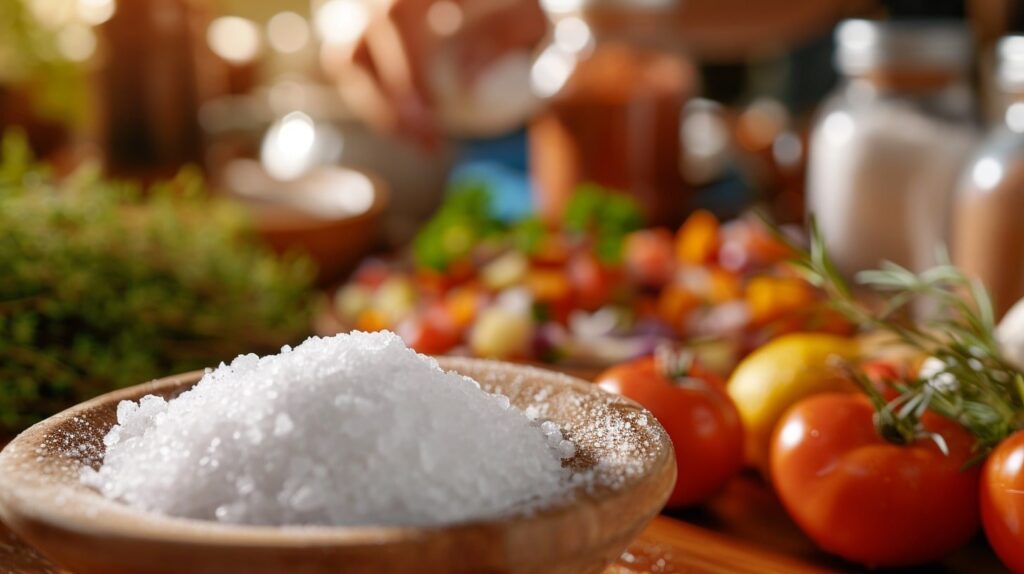Table of Contents
The phrase “you are what you eat” resonates more than ever when we talk about the impact of diet on health. One stealthy culprit often sprinkled generously across our meals is salt. While it’s a key ingredient for flavor, too much of it can lead to high blood pressure, a formidable risk factor for heart disease. But fear not! By shaking off the salt habit, embracing savory swaps, and becoming a smart shopper, you can keep your heart health in check. This article, will help you navigate the path to a low-sodium lifestyle. For additional support, the ‘My Heartlet’ app offers personalized tips and tracks your health journey, ensuring your heart stays as happy as your taste buds!
Shake Off the Salt Habit!
High sodium intake is directly linked to elevated blood pressure levels, which can put unnecessary strain on your heart. According to the American Heart Association, the average American consumes more than 3,400 milligrams of sodium daily, significantly higher than the recommended limit of 2,300 milligrams. One of the most effective ways to reduce salt intake is by being mindful of the hidden sodium in processed and packaged foods. These foods can be deceptively high in salt content, even if they don’t taste particularly salty.
Another crucial step is understanding the connection between salt and flavor. We’re often conditioned to believe that salt is the primary source of flavor in our meals. However, the truth is that our taste buds can adapt over time to enjoy less salty foods. Initiating this change can start with simple habits like removing the salt shaker from your dining table, and being cautious with the amount of salt added during cooking.
Lastly, it’s important to recognize the role of high-sodium condiments like soy sauce, ketchup, and salad dressings. Opting for their low-sodium versions or making homemade alternatives can drastically cut down your overall salt consumption. Remember, reducing salt intake is a gradual process, and every small step counts towards better heart health.
Savory Swaps: Herbs Over Salt
Transforming your meals from salt-laden to herb-infused can be a delightful culinary adventure. Herbs and spices offer a bounty of flavors that can easily outshine the need for excess salt. For example, basil can add a fresh, peppery flavor to salads and pasta dishes, while cumin brings a warm, earthy note to meats and soups. Here are some savory swaps to consider:
- Use garlic powder instead of garlic salt for a robust flavor without the added sodium.
- Enhance the natural sweetness of vegetables with a sprinkle of dried herbs like oregano or thyme.
- Add a dash of smoked paprika to give dishes a rich, smoky depth that often eliminates the need for additional salt.
- Experiment with spice blends like Italian seasoning or Herbes de Provence to instantly elevate the taste profile of your meals.
Incorporating these flavorful alternatives not only benefits your health but also broadens your culinary repertoire. As you become more accustomed to these new flavors, your palate will start to appreciate the complexity of herbs and spices, making the transition away from salt a seamless one.
Smart Shopping: Low-Sodium Finds

Navigating the grocery store aisles can be a minefield when it comes to sodium content. But with a few smart shopping strategies, you can arm yourself with the knowledge to make healthier choices. Always take a moment to compare food labels and opt for the products with lower sodium levels. Here’s a quick list of tips to help you shop smart:
- Look for “low-sodium,” “reduced sodium,” or “no salt added” labels on canned goods.
- Choose fresh or frozen vegetables over canned ones, which often contain added salt for preservation.
- Be wary of packaged snacks, like chips and crackers; opt for unsalted nuts or seeds instead.
- When selecting bread and cereals, aim for those with the lowest sodium content per serving.
The ‘My Heartlet’ app can be a great companion during your grocery trips, offering guidance on making heart-healthy choices and tracking your sodium intake. With these shopping tips and the app’s insights, you’ll be well-equipped to fill your cart with low-sodium treasures that support your health goals.
In conclusion, reducing salt intake doesn’t have to mean sacrificing flavor or enjoyment of food. By shaking off the salt habit, making savory swaps with herbs and spices, and shopping smartly for low-sodium products, you can embrace a heart-healthy diet that’s both delicious and nutritious. Remember to utilize tools like the My Heartlet app to monitor your progress and stay informed. So go ahead, season your life with a variety of tastes, and let your heart thank you for the sprinkle of love and care you’ve added to your meals.
